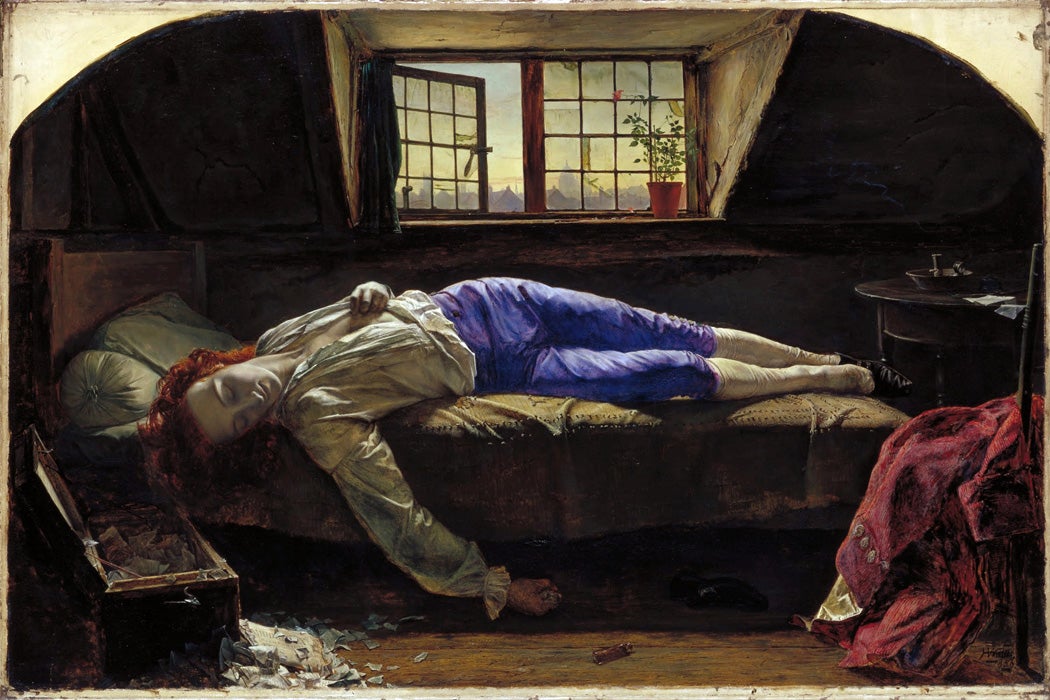Once upon a time, Thomas Chatterton was the famous dead poet. Chatterton (1752-1770) had already been dead for decades when he was taken up like a kind of mascot by the Romantics, including William Wordsworth, Samuel Taylor Coleridge, John Keats, Percy Bysshe Shelley, and Lord Byron.
For them, Chatterton—who famously killed himself a few months before his eighteenth birthday—was the quintessence of the tormented, misunderstood, starving poet who dies alone, young and unknown. He was the prototype of the teenage poète maudit long before Rimbaud.
Chatterton’s suicide fit with the Romantic sense of tragedy. That he might not have killed himself was beside the point. In his re-evaluation of Chatterton’s work, cultural historian Ivan Phillips notes that Chatterton may have died by accident, taking too much of what passed for medicine for his venereal disease. But Chatterton’s posthumous legend made it suicide, the epitome of the much more recent adage “live fast, die young, and leave a good-looking corpse.” This was, after all, the era of the pan-European phenomenon of Goethe’s Sorrows of Young Werther. Werther’s fictional suicide had inspired a spate of actual youthful copycats.
Whatever Chatterton’s cause of death, when he died he “left behind a massive body of ‘acknowledged’ poems, letters, sketches, dramas, and essays, and an only slightly smaller body of poems, letters, sketches, dramas, and essays purporting to be by (or translated from) a cast of historical figures […].” Many of these forgeries were said (by Chatterton) to be written by a fifteenth-century monk named Thomas Rowley, so they’ve been called the “Rowley poems” ever since.
Phillips notes this divide in Chatterton’s work: “authentic but dull on one side, forged and fascinating on the other.” The reams of Chatterton’s work under his own name “have rarely been anyone’s concern,” but the fakes caused “learned dispute and extravagant enthusiasm (though precious little critical analysis) almost before the author was cold in his workhouse lime-pit.”
After all, this was the eighteenth century, the “golden age of literary forgeries” calling upon an imagined past, using that imagined past to create new traditions. The Ossian poems were the most famous of these. Even Horace Walpole’s The Castle of Otranto (1749), the first Gothic novel, purported to be a translation of a text from a sixteenth-century Italian named Onuphrio Muralto.
Weekly Digest
Chatterton didn’t merely write a few pseudo-medieval poems. He forged entire manuscripts. These, writes Phillips, were “forgeries in the strictest sense, reproductions of nothing, they are ready-mades that were assembled but never found, neither copies nor—according to any traditional understanding—originals.” The precocious Chatterton’s fake oeuvre is made up of “distressed parchment, singed and sooty, waxy, ragged, ink-blotted, fragile.” Philips goes on to describe them as “complex tactile and visual objects which revolt against print culture because they are both chimerical—they are forgeries of things which never existed—and unrepeatable.” Modern spellchecking software, he suggests, would melt down when tasked with Chatterton’s work.
“Rarely in print, infrequently read, critically untended,” Chatterton was almost all myth for the Romantics. Wordsworth, who was born the year Chatterton died, apostrophized him as “the marvelous Boy/ The sleepless Soul that perished in his pride.” Then the reputation-tidying Victorians got their hands on him. He was “cleaned up by the Victorians, all but cleared away by the twentieth century.” Yet Phillips finds Chatterton’s body of ersatz Medievalism surprisingly relevant in our own age. In Chatterton’s pre-modern work he finds both modernity and post-modernity, and a fascinating example of “the cultural force of forgery in general, and a uniquely adaptable politics of style.”







